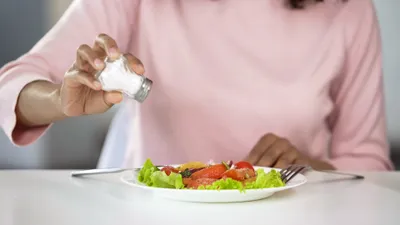Health
India Targets Excess Salt Intake with Health Advisory Initiative

The Union Health Ministry of India recently launched an initiative aimed at curbing the excessive salt consumption among its citizens. This advisory, issued in March 2024, encourages government institutions and workplaces to install boards displaying information about oil and sugar content in food products. While the focus on reducing sugar and oil is important, experts warn that salt, another significant health risk, must not be overlooked.
According to the World Health Organization (WHO), adults should consume less than 5-6 grams of salt per day, approximately equivalent to one teaspoon. However, research conducted by the Indian Council of Medical Research (ICMR) reveals that urban Indians consume an alarming average of 9.2 grams daily, with rural areas averaging around 5.6 grams. This excessive intake is primarily attributed to home-cooked meals, which often include substantial amounts of added salt, particularly in traditional foods such as pickles, chutneys, and buttermilk.
Health risks associated with high salt consumption are significant. Excessive intake can lead to hypertension, increasing the chances of heart disease, stroke, and kidney disorders. In India, approximately 175,000 deaths annually are linked to high salt consumption, primarily due to its contribution to hypertension-related complications.
Raising Awareness About Salt Intake
Experts emphasize the importance of increasing public awareness regarding salt consumption. They recommend that individuals learn to read food labels to identify hidden sources of salt in various products. Common items such as cookies, biscuits, and even bread can contain high sodium levels, often due to additives like baking soda and monosodium glutamate (MSG).
To help individuals reduce their daily salt intake, health professionals suggest several practical strategies. Gradually decreasing the amount of salt added to meals can help, as can avoiding table salt altogether. Those with a history of hypertension or high blood pressure should consider switching to low-sodium salt alternatives.
Enhancing flavors with herbs, spices, and natural acids like lemon juice can also make meals enjoyable without the need for added salt. Limiting traditional salty snacks such as pickles and papad, as well as processed foods, is crucial. When using canned ingredients, rinsing them thoroughly can help reduce their sodium content, as many are packed in saline water.
Making Informed Choices
Awareness of hidden salt sources is an essential part of managing dietary intake. Packaged sauces and salad dressings often contain high sodium levels, so opting for homemade versions or simpler dressings like vinegar or citrus juice can be beneficial. It’s important to note that different types of salt, including pink salt, rock salt, and sea salt, all contain similar sodium levels to regular table salt.
Ultimately, informed choices and increased awareness remain key to reducing salt intake. As the Union Health Ministry continues its efforts to promote healthier eating habits, the emphasis on salt must be integrated into broader dietary guidelines. By taking these steps, individuals can significantly improve their health and reduce the risk of serious conditions associated with excessive salt consumption.
-

 World5 months ago
World5 months agoSBI Announces QIP Floor Price at ₹811.05 Per Share
-

 Lifestyle5 months ago
Lifestyle5 months agoCept Unveils ₹3.1 Crore Urban Mobility Plan for Sustainable Growth
-

 Science4 months ago
Science4 months agoNew Blood Group Discovered in South Indian Woman at Rotary Centre
-

 World5 months ago
World5 months agoTorrential Rains Cause Flash Flooding in New York and New Jersey
-

 Top Stories5 months ago
Top Stories5 months agoKonkani Cultural Organisation to Host Pearl Jubilee in Abu Dhabi
-

 Sports4 months ago
Sports4 months agoBroad Advocates for Bowling Change Ahead of Final Test Against India
-

 Science5 months ago
Science5 months agoNothing Headphone 1 Review: A Bold Contender in Audio Design
-

 Top Stories5 months ago
Top Stories5 months agoAir India Crash Investigation Highlights Boeing Fuel Switch Concerns
-

 Business5 months ago
Business5 months agoIndian Stock Market Rebounds: Sensex and Nifty Rise After Four-Day Decline
-

 Sports4 months ago
Sports4 months agoCristian Totti Retires at 19: Pressure of Fame Takes Toll
-

 Politics5 months ago
Politics5 months agoAbandoned Doberman Finds New Home After Journey to Prague
-

 Top Stories5 months ago
Top Stories5 months agoPatna Bank Manager Abhishek Varun Found Dead in Well









